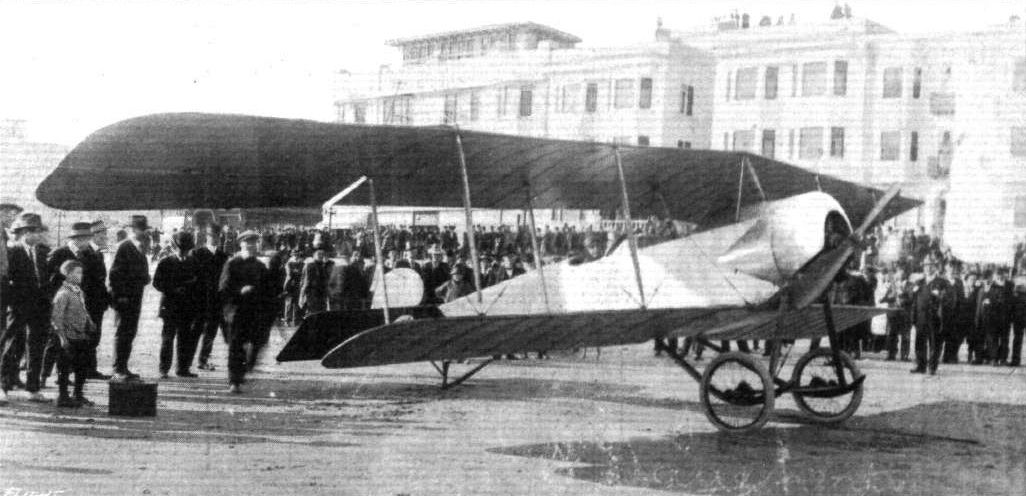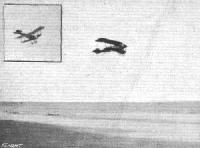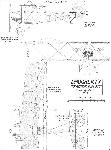
Описание
Страна: США
Год: 1915
Журнал Flight
Flight, May 28, 1915.
THE DAUGHERTY TRACTOR BIPLANE.
EARL S. DAUGHERTY, the well-known American pilot, who claims to have flown more types of machines than any other American pilot, is responsible for the design of the very "business-like-looking" machine shown in the accompanying illustrations and scale drawings. It was built for him at Chicago last winter by Max Stupar, and on it he has been making numerous successful flights at Long Beach.
It is a tractor biplane with swept-back wings, following the practice of certain German types, but otherwise it is more or less original in design. Special attention has been given to the quick assembling and dismantling of the various parts, so that it should be specially suitable for military or exhibition purposes. Top and bottom planes have a span of 38 ft. and 26 ft. respectively, whilst the respective chords are 5 ft. and 4 ft. The top plane is divided into four sections, consisting of two inner sections, 11 ft. span each, divided in the centre, and two outer extensions 8 ft. each. The inner ends of the centre sections are attached to two pairs of inverted V struts mounted above the body, and the two lower plane sections abut against the bottom longitudinals of the body, quick detachable fittings being employed. Four pairs of streamline spruce struts separate the top and bottom planes, which are 4 ft. 6 ins. apart, and cable is employed for bracing the same. The top attachment of the interplane struts, is by means of eye-bolts fixed to the spars, and the attachment to the lower plane is by quick detachable fittings which permit the withdrawal of the struts without interfering with the adjustment of the bracing. If required the top plane extensions can be replaced by small sections so as to give a total span of 26 ft., for speed work. The planes are built up on two spars, the front ones of D section, forming the leading edge and the rear ones of rectangular section, spaced 3 ft. 6 ins. from the former; both front and rear spars measure 1 1/4 ins. by 1 3/4 ins. The ribs are built up of spruce battens and webs, glued and nailed together, and fastened front and back to the spars by metal strips. They are spaced at intervals of about 1 ft., and have a maximum thickness of 1 1/4 ins. The wing section has a maximum camber of 31/4 ins. for the top plane, that of the lower plane being in proportion, situated at a point 30 per cent, of the chord from the leading edge. The whole wing framework is strongly braced with steel wire, and covered with linen treated with Emaillite. Hinged to the rear spars of the top plane extensions are the balancing flaps, which are interconnected. The tail planes consist of a fixed surface, 10 sq. ft. area, of very high aspect ratio, hinged to which are two elevator flaps of about 10 sq. ft. each, with a partly balanced vertical rudder mounted between them. The tail is protected by a rubber sprung skid.
The body is of rectangular section, divided into two portions to facilitate shipment. The longitudinals and struts of the front section are of ash, and those of the rear half are of spruce. The engine, a 50 h.p. Gnome, is mounted in the nose of the body, and partially enclosed by a metal cowl. Immediately behind the engine is the passenger's cockpit, and behind that again, at the rear of the trailing edge of the top plane, is the pilot's. The body is fabric-covered, at the rear half, whilst the fore-portion is covered with metal sheeting. The control is of the Farman type, consisting of a universally jointed lever for the balancing flaps and elevators, and a horizontal foot-bar for the rudder. For school work a dual control is provided, which can be disconnected by the pilot at will. The under-carriage consists of two curved laminated skids which are connected to the body at their rear ends, and two short struts, 22 ins. in length, forming a connection with the body at the forward ends. A pair of 28 in. wheels are mounted on a 1 7/8 in. tubular steel axle, which is attached to the skids by rubber shock-absorbers. The whole of the landing gear can be detached from the body by the removal of four 5/8 pins. The fuel tanks have a capacity of 15 gallons of petrol and 8 gallons of oil, and provision is made for an extra petrol tank in the passenger compartment.
On the dash in front of the pilot is a full range of instruments, such as barograph, gradometer, revolution indicator, and also switches for an electric searchlight to be used for night work. The weight of this machine comes out at about 540 lbs. empty. We understand that Mr. Daugherty has just recently had a demonstration of the strength of his machine through an accident at Long Beach. Owing to a mishap to the control gear whilst making a banked turn, the machine fell to the ground, landing full on the motor. In spite of this, the machine was not beyond repair, and will be flying again shortly.
- Журнал Flight
Фотографии
-
Журнал - Flight за 1915 г.
Three-quarter front view of the Daugherty tractor biplane.
-
Журнал - Flight за 1915 г.
The Daugherty tractor biplane in flight at Long Beach.
-
Журнал - Flight за 1915 г.
Earl S. Daugherty in the pilot's seat of his tractor biplane.
-
Журнал - Flight за 1915 г.
Plan, front and side elevation to scale of the Daugherty tractor biplane.




